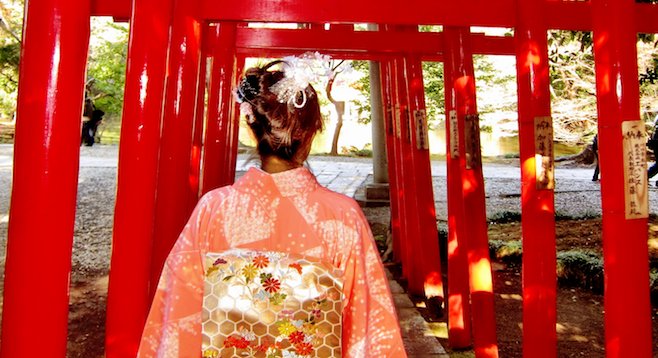 Facebook
Facebook
 X
X
 Instagram
Instagram
 TikTok
TikTok
 Youtube
Youtube

Located in the Saitama Prefecture of Japan, Ōmiya is just a 30-minute bullet train ride from Tokyo, yet the town feels much farther away from its hustle and bustle.
Eye-catching features of Ōmiya include bonsai trees, kimonos and a shrine with almost 2,000 years of history. If visiting Asakusa and its temples doesn’t provide enough respite from loud Tokyo, why not visit quieter Ōmiya?
A mere 20-minute walk from the Ōmiya station is the Bonsai Village and surrounding bonsai nurseries. Visiting the Bonsai Village and its art gallery costs a cheap 300 yen, and entrance is free at the bonsai nurseries that feature numerous bonsai, each with their own unique design. All of the bonsai sites are nestled together in a sleepy neighborhood, with only the sound of wind rustling through bamboo trees to be heard while walking between each site.
As bonsai enthusiasts, our only reason for visiting Ōmiya was for the bonsai – yet upon further research about the area, I just happened to find information about the Sakaeya Kimono Shop located a 15-minute walk from Ōmiya station. I was particularly attracted to this shop because it looked small and family-run.
In business for 50 years, Kahori, the owner, was prompt and thorough in securing my reservation. For 8000 yen, I could be dressed in kimono, tour the Hikawa Shrine, take part in a traditional tea ceremony, and do as much picture taking as my heart desired.
I was surprised by the strength of Kahori’s mother, who dressed me in layers so that my kimono pictures against the backdrop of the Hikawa Shrine grounds – also known as “Musashi Ici-no-miya,” where “Ici-no-miya” means "the most prestigious shrine" – were spectacular. A 10-minute walk in zōri sandals made for prime photo opps.
Enter the shrine through looming wooden torii gates shaded by Japanese elm and follow the path that branches out to bonsai, ponds, bridges and mini-waterfalls before arriving at the shrine to pay respects and make a wish. Exit the site via neighboring Ōmiya Park, which I hear is most gorgeous during cherry blossom season.
After such a long day of walking, hunger struck, but fortunately our search for food was easy. True to its role as a major transportation hub, Ōmiya train station provides a range of sustenance options, including tempura, noodles soups, pastry shops and curry eateries.


Located in the Saitama Prefecture of Japan, Ōmiya is just a 30-minute bullet train ride from Tokyo, yet the town feels much farther away from its hustle and bustle.
Eye-catching features of Ōmiya include bonsai trees, kimonos and a shrine with almost 2,000 years of history. If visiting Asakusa and its temples doesn’t provide enough respite from loud Tokyo, why not visit quieter Ōmiya?
A mere 20-minute walk from the Ōmiya station is the Bonsai Village and surrounding bonsai nurseries. Visiting the Bonsai Village and its art gallery costs a cheap 300 yen, and entrance is free at the bonsai nurseries that feature numerous bonsai, each with their own unique design. All of the bonsai sites are nestled together in a sleepy neighborhood, with only the sound of wind rustling through bamboo trees to be heard while walking between each site.
As bonsai enthusiasts, our only reason for visiting Ōmiya was for the bonsai – yet upon further research about the area, I just happened to find information about the Sakaeya Kimono Shop located a 15-minute walk from Ōmiya station. I was particularly attracted to this shop because it looked small and family-run.
In business for 50 years, Kahori, the owner, was prompt and thorough in securing my reservation. For 8000 yen, I could be dressed in kimono, tour the Hikawa Shrine, take part in a traditional tea ceremony, and do as much picture taking as my heart desired.
I was surprised by the strength of Kahori’s mother, who dressed me in layers so that my kimono pictures against the backdrop of the Hikawa Shrine grounds – also known as “Musashi Ici-no-miya,” where “Ici-no-miya” means "the most prestigious shrine" – were spectacular. A 10-minute walk in zōri sandals made for prime photo opps.
Enter the shrine through looming wooden torii gates shaded by Japanese elm and follow the path that branches out to bonsai, ponds, bridges and mini-waterfalls before arriving at the shrine to pay respects and make a wish. Exit the site via neighboring Ōmiya Park, which I hear is most gorgeous during cherry blossom season.
After such a long day of walking, hunger struck, but fortunately our search for food was easy. True to its role as a major transportation hub, Ōmiya train station provides a range of sustenance options, including tempura, noodles soups, pastry shops and curry eateries.
Comments